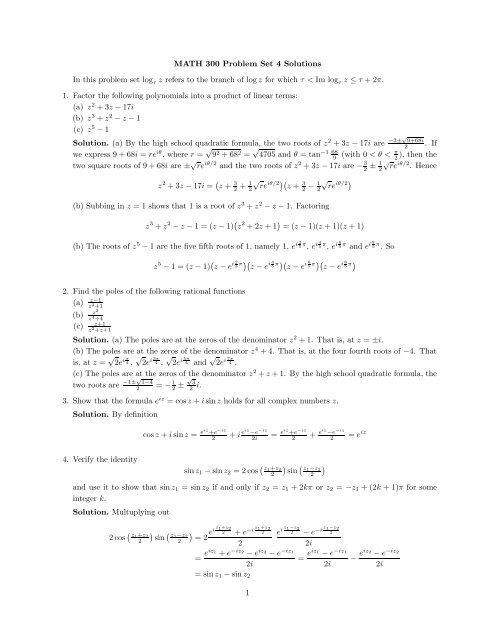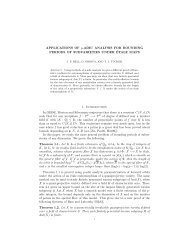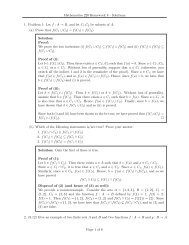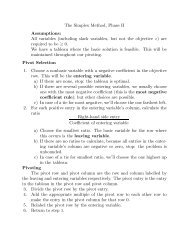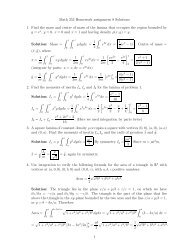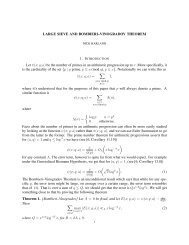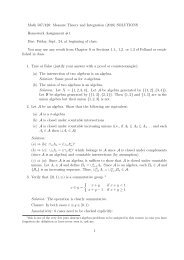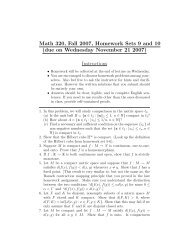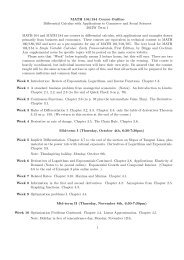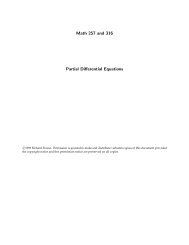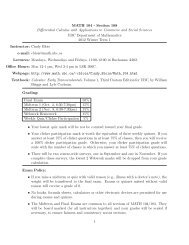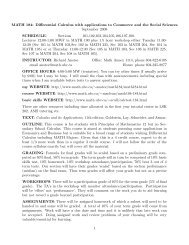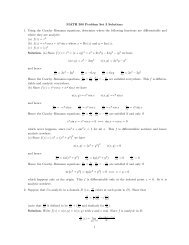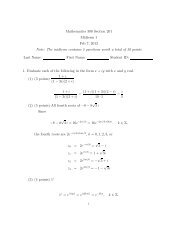MATH 300 Problem Set 4 Solutions In this problem set logτ z refers ...
MATH 300 Problem Set 4 Solutions In this problem set logτ z refers ...
MATH 300 Problem Set 4 Solutions In this problem set logτ z refers ...
You also want an ePaper? Increase the reach of your titles
YUMPU automatically turns print PDFs into web optimized ePapers that Google loves.
<strong>MATH</strong> <strong>300</strong> <strong>Problem</strong> <strong>Set</strong> 4 <strong>Solutions</strong><br />
<strong>In</strong> <strong>this</strong> <strong>problem</strong> <strong>set</strong> log τ z <strong>refers</strong> to the branch of logz for which τ < Im log τ z ≤ τ +2π.<br />
1. Factor the following polynomials into a product of linear terms:<br />
(a) z 2 +3z −17i<br />
(b) z 3 +z 2 −z −1<br />
(c) z 5 −1<br />
Solution. (a) By the high school quadratic formula, the two roots of z2 +3z −17i are −3±√9+68i 2<br />
we express 9+68i = reiθ , where r = √ 92 +682 = √ −1 68 π<br />
4705 and θ = tan 9 (with 0 < θ < 2<br />
two square roots of 9+68i are ± √ reiθ/2 and the two roots of z2 +3z −17i are −3 1<br />
2 ± 2<br />
z 2 +3z −17i = z + 3 √ 1 iθ/2<br />
2 + 2 re z + 3 √ 1 iθ/2<br />
2 − 2 re <br />
(b) Subbing in z = 1 shows that 1 is a root of z 3 +z 2 −z −1. Factoring<br />
z 3 +z 2 −z −1 = (z −1) z 2 +2z +1 = (z −1)(z +1)(z +1)<br />
(b) The roots of z 5 −1 are the five fifth roots of 1, namely 1, e i2<br />
5 π , e i4<br />
5 π , e i6<br />
5 π and e i8<br />
5 π . So<br />
z 5 −1 = (z −1) z −e i2<br />
5 π z −e i4<br />
5 π z −e i6<br />
5 π z −e i8<br />
5 π<br />
2. Find the poles of the following rational functions<br />
(a) z−1<br />
z 2 +1<br />
(b) z 2<br />
z 4 +4<br />
(c) z+1<br />
z 2 +z+1<br />
Solution. (a) The poles are at the zeros of the denominator z 2 +1. That is, at z = ±i.<br />
. If<br />
), then the<br />
√ iθ/2 re . Hence<br />
(b) The poles are at the zeros of the denominator z4 +4. That is, at the four fourth roots of −4. That<br />
is, at z = √ 2eiπ 4, √ 2ei3π 4 , √ 2ei5π 4 and √ 7π i 2e 4 .<br />
(c) The poles are at the zeros of the denominator z2 +z+1. By the high school quadratic formula, the<br />
two roots are −1±√ 1−4<br />
2 = − 1<br />
2 ± √ 3<br />
2 i.<br />
3. Show that the formula e iz = cosz +isinz holds for all complex numbers z.<br />
Solution. By definition<br />
4. Verify the identity<br />
cosz +isinz = eiz +e −iz<br />
2 +i eiz −e −iz<br />
2i = eiz +e −iz<br />
2 + eiz −e −iz<br />
2 = e iz<br />
sinz1 −sinz2 = 2cos z1+z2<br />
2<br />
z1−z2<br />
sin 2<br />
and use it to show that sinz1 = sinz2 if and only if z2 = z1 + 2kπ or z2 = −z1 + (2k + 1)π for some<br />
integer k.<br />
Solution. Multuplying out<br />
2cos z1+z2<br />
2<br />
e z1−z2<br />
sin 2 = 2 iz 1 +z2 2 +e−iz 1 +z2 2<br />
2<br />
= eiz1 +e −iz2 −e iz2 −e −iz1<br />
2i<br />
= sinz1 −sinz2<br />
1<br />
eiz 1−z2 2 −e−iz 1−z2 2<br />
2i<br />
= eiz1 −e −iz1<br />
2i<br />
− eiz2 −e −iz2<br />
2i
as desired. Consequently,<br />
sinz1 = sinz2 ⇐⇒ sinz1 −sinz2 = 0 ⇐⇒ cos z1+z2 z1−z2<br />
2 sin 2 = 0<br />
⇐⇒ cos <br />
z1+z2 z2−z1<br />
2 = 0 or sin 2 = 0<br />
⇐⇒ z1+z2 1 z2−z1<br />
2 = 2 (2k +1)π or 2 = kπ for some k ∈ Z<br />
⇐⇒ z2 = −z1 +(2k +1)π or z2 = z1 +2kπ for some k ∈ Z<br />
Here we have used that<br />
cosz = 0 ⇐⇒ e iz +e −iz = 0 ⇐⇒ e iz = −e −iz ⇐⇒ e 2iz = −1 ⇐⇒ z = 1<br />
2 (2k +1)π for some k ∈ Z<br />
sinz = 0 ⇐⇒ e iz −e −iz = 0 ⇐⇒ e iz = e −iz ⇐⇒ e 2iz = 1 ⇐⇒ z = kπ for some k ∈ Z<br />
5. Show that the mapping w = sinz is one–to–one in the semi–infinite strip<br />
S1 = x+iy −π < x < π, y > 0 <br />
That is, show that if z1 and z2 are in S1 and sinz1 = sinz2, then z1 = z2. Find the image of <strong>this</strong> strip.<br />
Solution. Let z1 = x1 +iy1 and z2 = x2 +iy2 both be in the strip S1. By the last question,<br />
sinz1 = sinz2 ⇐⇒ z2 = −z1 +(2k +1)π or z2 = z1 +2kπ for some k ∈ Z<br />
⇐⇒ x2 = −x1 +(2k +1)π, y2 = −y1 or x2 = x1 +2kπ,y2 = y1 for some k ∈ Z<br />
Since both x1 + iy1 and x2 + iy2 lie in S1, we necessarily have both y1 > 0 and y2 > 0. So “x2 =<br />
−x1 +(2k+1)π, y2 = −y1 for some k ∈ Z” cannot happen. We also necessarily have the −π < x1 < π<br />
and −π < x2 < π and hence |x1 −x2| < 2π. So “x2 = x1 +2kπ, y2 = y1 for some k ∈ Z” can happen<br />
only for k = 0, in which case z1 = z2. This completes the proof that sinz is one–to–one in S1.<br />
We now determine the image of S1. For z = x+iy,<br />
sinz = sin(x+iy) = eix−y −e −ix+y<br />
2i<br />
= ey +e −y<br />
2 sinx+i ey −e −y<br />
2 cosx<br />
= 1<br />
2i<br />
e −y (cosx+isinx)−e y (cosx−isinx) <br />
For each fixed y > 0, as x runs from −π to π, the point sin(x+iy) = ey +e −y<br />
2 sinx+i ey −e −y<br />
2 cosx runs<br />
around an ellipse (starting just to the left of the negative imaginary axis near −i ey −e −y<br />
2 and ending<br />
just to the right of the negative imaginary axis near −i ey −e −y<br />
2 ) with semimajor axis ey +e −y<br />
2 > 1 and<br />
semiminor axis ey −e −y<br />
2 > 0. When y > 0 is very close to zero, the semimajor axis is just a bit bigger<br />
than 1 and the semiminor axis is just a bit bigger than 0, as for the smallest ellipse in the figure below.<br />
As y increases both semiaxes increase in size and both tend to infinity as y tends to infinity. For y large,<br />
the ellipse is almost circular, as for the largest ellipse in the figure below. The <strong>set</strong> of points covered is<br />
<br />
<br />
<br />
−π < x < π<br />
y>0<br />
sin(x+iy) = ey +e −y<br />
2 sinx+i ey −e −y<br />
2 cosx<br />
which is the union of all of the ellipses, excluding the intersection of the ellipse with the negative<br />
imaginary axis. This is the entire complex plane, except for the negative imaginary axis and the line<br />
segment y = 0, −1 < x < 1, as sketched in the figure<br />
2
6. Find all values of the following:<br />
(a) Log(1−i)<br />
(b) log(1+i)<br />
(c) log 3π (−1+ √ 3i)<br />
Solution. (a) <strong>In</strong> polar coordinates 1−i = √ 2e−iπ 4 = e 1<br />
2 ln2−iπ 4. So log(1−i) = 1<br />
2 ln2−iπ 4 +2kπi with<br />
k running over Z. The principal value of the logarithm chooses the k for which the imaginary part is<br />
between −π and π, namely k = 0. So Log(1−i) = 1<br />
2 ln2−iπ 4 .<br />
(b) <strong>In</strong> polar coordinates 1+i = √ 2eiπ 4 = e 1 π<br />
2 ln2+i 4. So log(1+i) = 1<br />
2 ln2+iπ 4 +2kπi with k running<br />
over Z.<br />
(b) <strong>In</strong> polar coordinates −1+ √ 3i = 2ei2π 2π<br />
3 ln2+i = e 3 . So log(−1+ √ 3i) = ln2 + i2π 3 + 2kπi with k<br />
running over Z. log 3π chooses the k for which the imaginary part is between 3π and 5π, namely k = 2.<br />
So log 3π (−1+ √ 3i) = ln2+i 2π<br />
3<br />
+4πi = ln2+i14π<br />
3 .<br />
7. Prove that Loge z = z if and only if −π < Imz ≤ π.<br />
Solution. We have loge z = z + 2kπi with k ∈ Z. For the principal branch we choose k ∈ Z so that<br />
−π < ImLoge z ≤ π. Since Re(z +2kπi) = Rez and Im(z +2kπi) = kπ +Imz, we have Loge z = z if<br />
and only if k = 0 and <strong>this</strong> is the case if and only if −π < Imz ≤ π.<br />
8. Show that the function f(z) = Log(−z) + iπ is a branch of logz in the domain D0 consisting of all<br />
points in the plane except those on the nonnegative real axis. (<strong>In</strong> other words, show that e f(z) = z and<br />
that f(z) is analytic on D0.)<br />
Solution.<br />
e f(z) = e Log(−z)+iπ = e Log(−z) e iπ = (−z)(−1) = z<br />
Denote by D− the <strong>set</strong> of all complex numbers except 0 and those on the negative real axis. Log(ζ) is<br />
analytic for all ζ ∈ D−. Hence f(z) = Log(−z) + iπ is analytic for all z obeying −z ∈ D−, which is<br />
precisely all z obeying z ∈ D0.<br />
9. Find a branch of log(z 2 +1) that is analytic at z = 0 and takes the value 2πi there.<br />
Solution. Observe that z 2 +1 = (z +i)(z −i). <strong>Set</strong> f(z) = Log(z +i)+Log(z −i)+2πi. Then<br />
e f(z) = e Log(z+i)+Log(z−i)+2πi = e Log(z+i) e Log(z−i) e 2πi = (z +i)(z −i)(1) = z 2 +1<br />
Denote by D− the <strong>set</strong> of all complex numbers except 0 and those on the negative real axis. The domain<br />
of analyticity of f(z) is the <strong>set</strong> of all z for which both z +i and z −i are in D−. This includes z = 0.<br />
Finally,<br />
f(0) = Log(0+i)+Log(0−i)+2πi = π π<br />
2i− 2i+2πi = 2πi<br />
10. For which values of τ do we have log τ(x) = lnx for all strictly positive real numbers x? Here lnx is the<br />
real natural logarithm.<br />
Solution. If x is a positive real number, then logx = lnx+2kπi with k ∈ Z. log τ x selects the value<br />
of k for which τ < 2kπ ≤ τ +2π. This value of k is zero if and only if −2π ≤ τ < 0.<br />
11. Let c be a nonzero constant. The multiple–valued function c z is given by c z = e zlogc . Show that by<br />
selecting a particular value of logc we obtain a branch of c z that is entire. Find the derivative of such a<br />
branch.<br />
3
Solution. Pick any particular value of logc and call it log τ c. The function g(z) = log τ c z (i.e.<br />
multiplication of z by the constant log τ c) is a polynomial and hence is entire. The function e zlog τ c is<br />
the composition of e z , which is entire, with g(z) and hence is also entire.<br />
d<br />
dzezlog τ c = (<strong>logτ</strong> c) e z<strong>logτ</strong> c<br />
12. By definition, θ = tan −1 z is the solution of tanθ = z. Derive the formulae<br />
(a) tan−1z = i i+z i<br />
2 log i−z = 2<br />
Solution. (a) For any z = ±i,<br />
1−iz<br />
d<br />
log 1+iz , z = ±i (b) dz tan−1z = 1<br />
1+z2, z = ±i<br />
tanθ = z ⇐⇒ sinθ<br />
2 e<br />
cosθ = z ⇐⇒ 2i<br />
iθ −e −iθ<br />
⇐⇒ (1−iz)e iθ = (1+iz)e −iθ ⇐⇒ e −2iθ = 1−iz<br />
1+iz<br />
⇐⇒ θ = i 1−iz<br />
2 log 1+iz<br />
To get the form i i+z<br />
2 log i−z<br />
(b)<br />
<br />
d i<br />
dz 2<br />
<br />
i+z i log i−z = 2<br />
d<br />
dz<br />
e iθ +e −iθ = z ⇐⇒ e iθ −e −iθ = iz e iθ +e −iθ<br />
⇐⇒ −2iθ = log 1−iz<br />
1+iz<br />
just multiply both the numerator and denominator of 1−iz<br />
1+iz<br />
<br />
i 1 −1 i<br />
log(i+z)−log(i−z) = 2 i+z − i−z = 2<br />
4<br />
2i<br />
(i+z)(i−z)<br />
by i.<br />
= − 1<br />
−1−z 2 = 1<br />
1+z 2


